It's not Easter unless I have my mom's Sicilian Easter Bread (cuddura cu l'ova). This traditional Easter bread with eggs nestled in it is the gift that my mom prepares for her children and grandchildren each year. 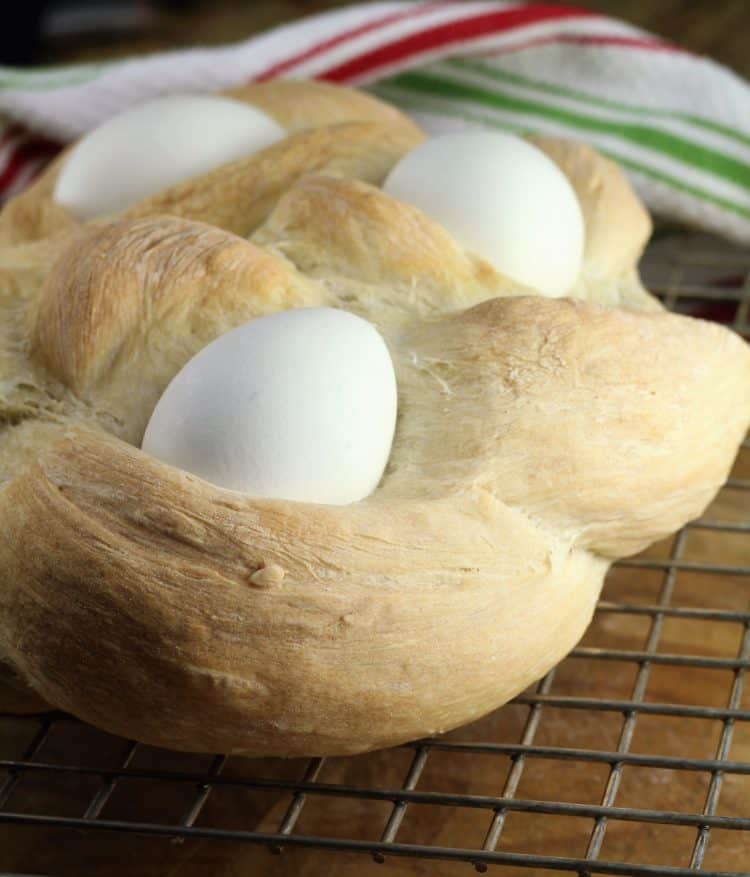
At this time of year most people have chocolate eggs, chicks or rabbits on their minds. Except for me! I look forward to my Sicilian Easter Bread (cuddura cu l'ova), a traditional braided Easter bread baked with eggs nestled in the dough. This is the gift that children in Sicily receive each Easter (at least they did back in my mother's day) and this is what I look forward to each year.
Most often cuddura cu l'ova is made with a slightly sweetened cookie dough decorated with sprinkles or icing as in these easter cookies with eggs. But I'm partial to this bread version which is perfect for enjoying with the baked eggs!
And of course, I do love love my Sicilian ricotta pie or my Pastiera at Easter time for dessert. But it would not be complete with cuddura!
What is cuddura?
So what exactly does cuddura mean? This word, in Sicilian dialect, has its origins in the Greek word "kollura" which means crown thus referring to the circular shape of the bread.
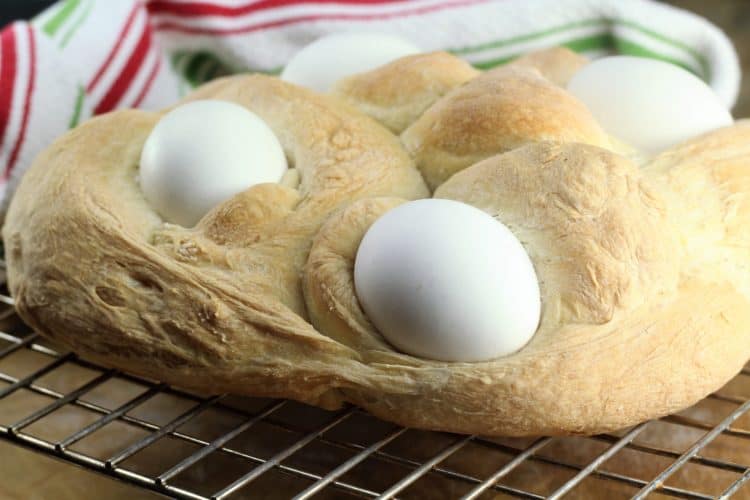
Watch my helpful video!
Step by Step Instructions:
- Begin by making a basic bread dough. Combine the yeast and sugar in a small bowl and cover with warm water. Let sit for 10 minutes.
- In a large bowl, combine flour and salt. Make a well in the center and pour in the prepared yeast. Stir together with a wooden spoon to make a soft dough.
- Pour the dough on to a well floured surface. It will be quite sticky at this point. Gradually add the remaining flour, kneading it into the dough. Knead for about 10 minutes until smooth, but still soft. Transfer to an oiled bowl, cover and let rise for 2 hours.
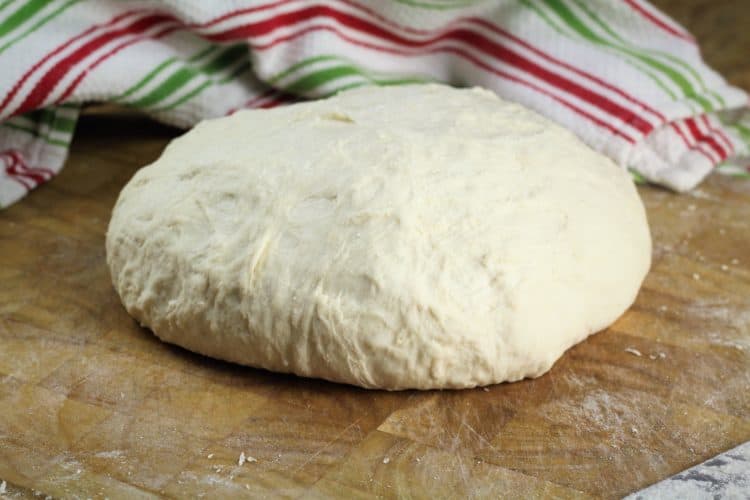
- Place the eggs in a bowl and cover with warm water while you shape the dough. When the dough has risen, cut in two. Working with one piece at a time, divide the dough in 3 and roll out each piece to about 20 inches.

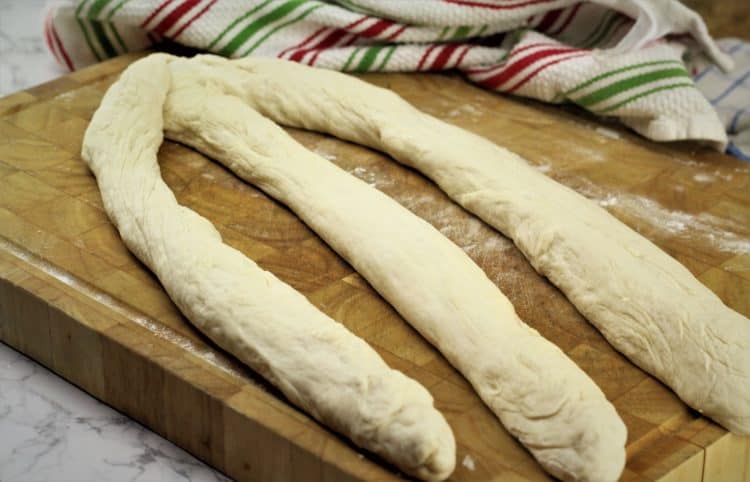
- Pinch the ends together and begin braiding the dough. Pinch the ends together.
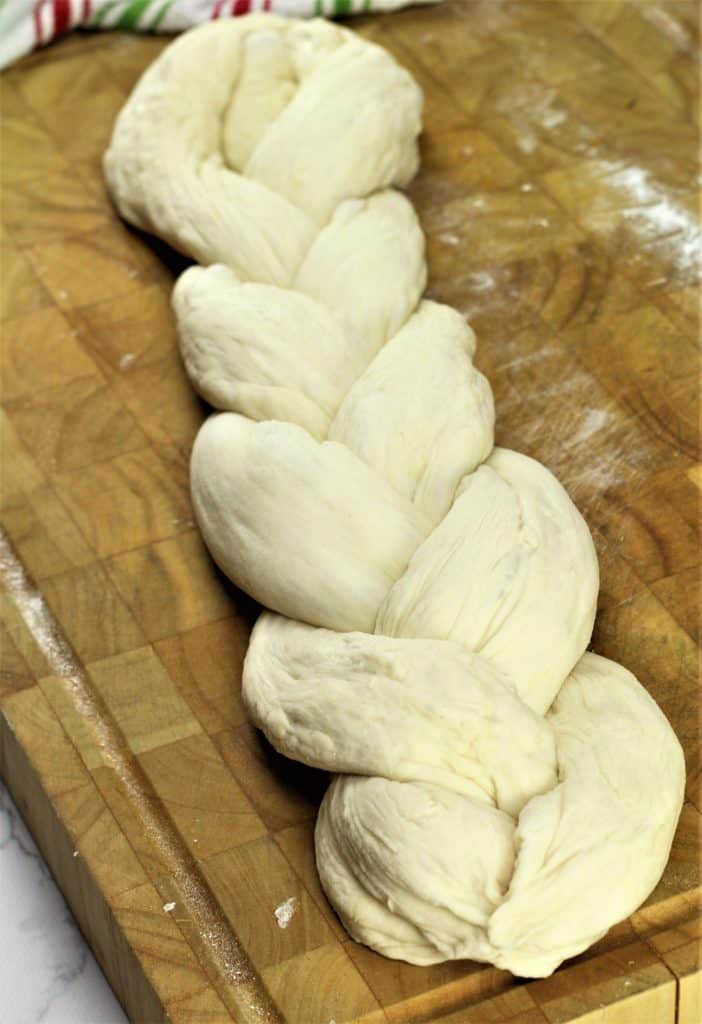
- Bring both ends together to form a circle. Nestle the eggs in the crooks of the braid. Preheat oven to 350F and let the cuddura rest while the oven preheats.
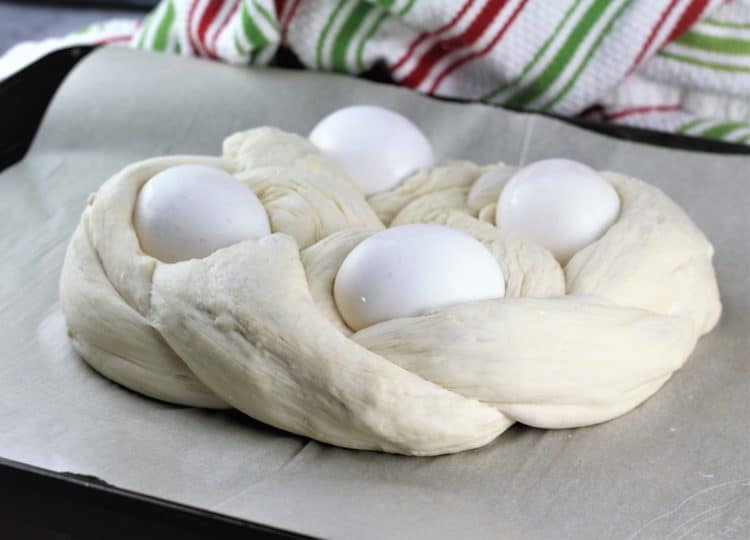
- Bake for about 45-60 minutes, until the bread is golden both on top and underneath. Let cool before serving.
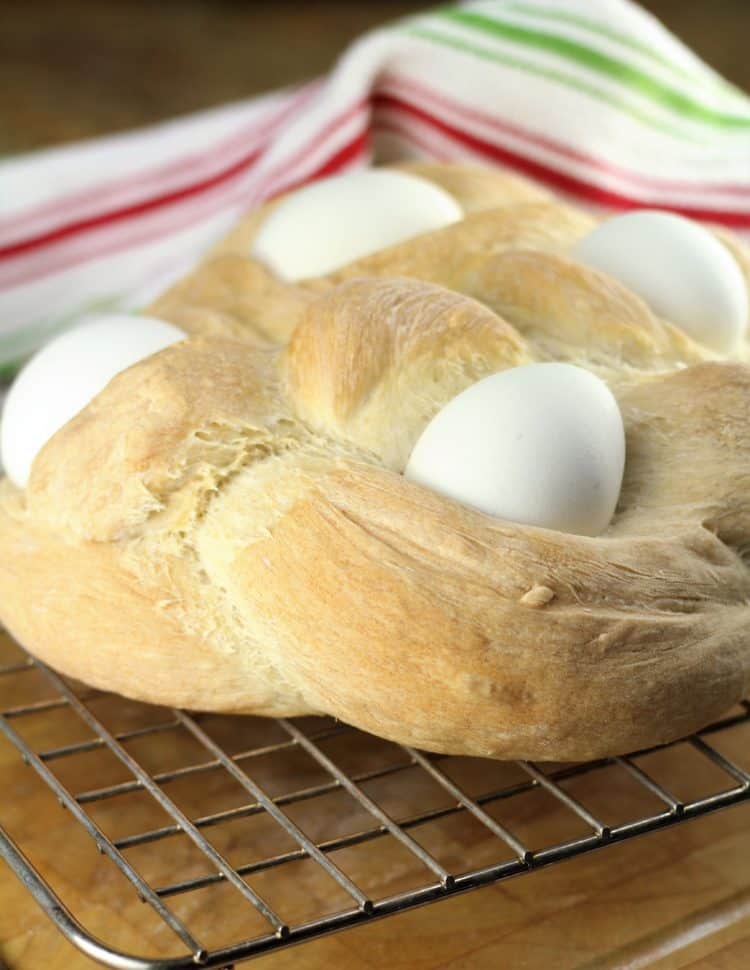
Recipe Notes:
Do the eggs need to be hard boiled before adding them to the bread dough?
- The eggs do not require boiling prior to baking. Place them in a bowl covered with warm water while you are shaping the dough. They will bake in the oven.
How to store Sicilian Easter bread:
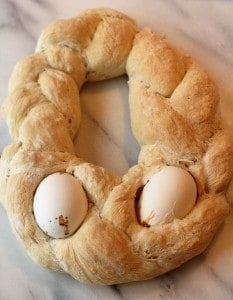
- Store the bread at room temperature for up to 3 days. Remove the eggs from the bread and store separately in the refrigerator.
Can the bread be frozen?
- The bread can also be frozen (without the eggs) for up to 3 months.
Different ways to shape Easter bread:
- For children, the bread may be shaped as a basket (as shown). This one was prepared by my mother for my daughter a few years ago.
To serve
Let me share with you our typical way of eating the eggs. Peel the eggs and mash lightly in a bowl. Add olive oil, salt and a bit of lemon juice. Yes, lemon juice! Trust me, it's delicious with the eggs and then the bread, of course, is a must to mop up all the bits of egg!
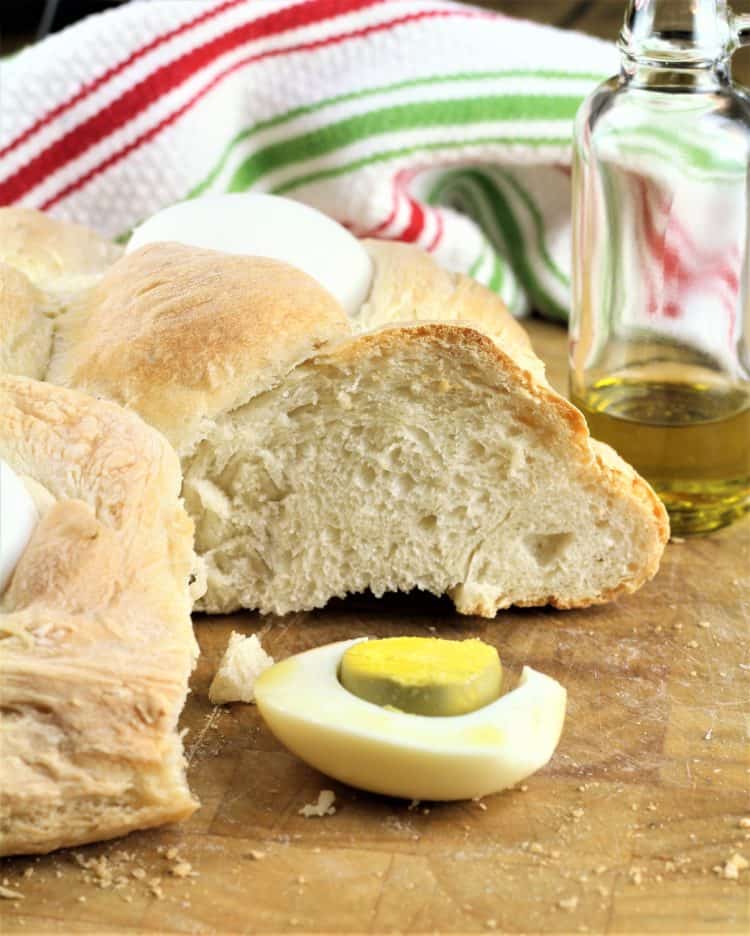
You know that your children, grandchildren, nephews and nieces will receive tons of chocolate this Easter, so why not start a new tradition and offer them homemade cuddura?
Let me know if you give this recipe a try. Don't forget to tag me with your photos with @mangiabedda or #mangiabedda on Facebook or Instagram. Happy Easter!
Here are more of my favorite recipes for Easter!
- Sweet Ricotta Easter Calzone
- Pizza Rustica (Easter Pie Recipe)
- Sicilian Easter Cookies with Eggs
- Easy No Crust Easter Pastiera
- Mom's Sicilian Ricotta Pie
- No Crust Italian Pear and Ricotta Cheesecake
- Pizza Rustica (Easter Pie Recipe)

Sicilian Easter Bread Recipe (cuddura cu l'ova)
Ingredients
- 3 ½ cups lukewarm water divided
- 1 package dry yeast (8 grams)
- 1 teaspoon granulated sugar
- 7 cups all-purpose flour divided
- 1 teaspoon salt
- 8 large eggs
Instructions
- Place yeast and sugar in a small bowl and add ½ cup of the lukewarm water. Let sit for 10 minutes.
- In a large bowl combine 3 ½ cups flour and salt. Make a well in the centre and pour in the yeast mixture. Add the remaining 3 cups of warm water and stir with a wooden spoon to form a dough.
- Place the dough on a lightly floured surface, it will be very sticky. Gradually add the remaining flour, kneading it into the dough. Knead about 10 minutes, until smooth and elastic.
- Place the dough in a lightly oiled bowl, cover with a cloth and let rise for 2 hours until doubled in bulk.
- Cover 2 baking sheets with parchment paper. Place eggs in a bowl, cover with hot tap water and let sit for 10 minutes while you shape the dough.
- Punch down the dough and divide in 2.
- Divide each half into 3 equal pieces. Roll each piece into a -20 inch long rope. Braid the 3 ropes and form a circle by pinching the ends together. Transfer to the prepared baking sheet.
- Nestle 4 eggs at equal intervals into the dough. To form a basket, nestle 2 eggs on the bottom of the braid and slightly lengthen the top part of the braid to shape the basket’s handle. Repeat with the remaining dough.
- Preheat oven to 350F. Let the cuddure rest while the oven preheats. Bake for approximately 45-60 minutes until the bread is golden on top and underneath. Let cool before slicing.
Notes
- The eggs do not require boiling prior to baking. Place in a bowl covered with warm water while you are shaping the dough. They will bake in the oven.
- Please note that baking time may vary according to each oven. The bread is ready when golden in color both on top and underneath. It will have a hollow sound when you tap it.
- Store the bread at room temperature for up to 3 days. Remove the eggs from the bread and store separately in the refrigerator.
- The bread can also be frozen (without the eggs) for up to 3 months.
- For children, the bread may be shaped as a basket as shown. This one was prepared by my mother for my daughter a few years ago.
Nutrition


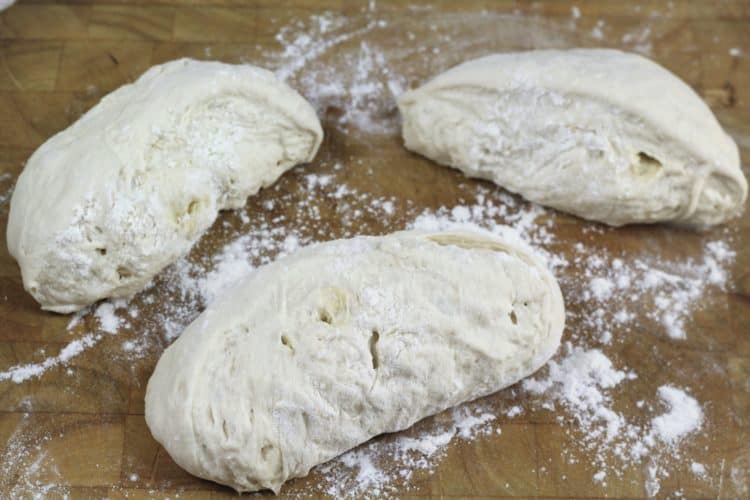
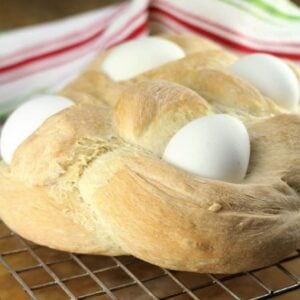
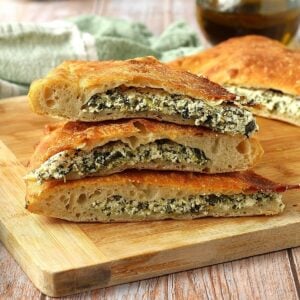

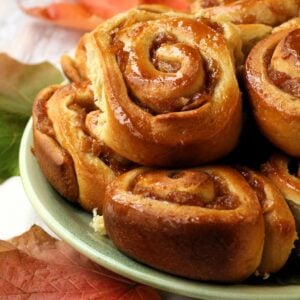
Charles Bruno Jr
My Grandfather who was Sicilian made a savory bread similar to this every Easter. His bread had the addition of melted lard, and instead of water the liquid was whole beaten eggs and a very liberal amount of black pepper mixed into the dough. Then the rising and the braiding into a circular loaf. I am only asking you about this as it is difficult to find anything about Easter Bread recipes that are savory; most everything is sweet style. Have you ever heard about this style of bread? I'd greatly appreciate any further info. After reading your recipe it's like i am so close to finding out about it yet so far. LOL!! Thanks in advance for a reply
Nadia
Hello Charles, I know that using lard in bread recipes is not uncommon however I have never tried it. I can just imagine how tasty your grandfather's bread was! You're right about there not being many savory Easter bread recipes out there, most of them are sweet and even coated in a sugary glaze. But this is how my mom has always prepared her Easter cuddura for us, simply based on her bread recipe. Why not modify my recipe by adding eggs, black pepper and even perhaps the lard? I'm all about experimenting with recipes until I find the one that works for me! If you do try let me know how it turns out. I can imagine how frustrating it must be to search for that precise flavor that brings us back to our childhood and all those wonderful memories!
Gigi
Hi Charles
My family are from Naples and we make the easter bread the same except we put cheese and salami. We make our own lard with fresh pork chops we dice and fry up and let sit until lsrd is formed. Then we add this to the bread. Same recipe but ours is definitely not sweet. We even add the cracked pepper corns too. We make it on good Friday and at midnight we all get together and eat the bread and eggs.
Nadia
Hi Gigi, that sounds delicious! Sounds similar to my sausage bread recipe. Happy Easter to you and your family!
Karen Gelvin
Thank you very much. You have no idea how much this means to me and my cousins. We miss my grandmother so much and this will give us something to remember her for the holiday.
Happy Easter to you and your family
mangiabedda@gmail.com
Hello Karen, you are very welcome! I totally understand your need to keep here memory alive through her recipes. Happy Easter to you and yours as well!
Karen Gelvin
My grandma was from Palermo and she used to make something that was similar to this. It was a boiled egg wrapped in a slightly sweet dough like a turnover. She would make one for each grandchild the day before Easter. She had a heavy Italian accent so we never really got the name of it but it sounded like “popacalova”. Have you heard of this or have recipe? We have all tried to remember it but it doesn’t come out
Like hers. Any help would be greatly appreciated. Thank you Karen Gelvin
mangiabedda@gmail.com
Hi Karen, I know exactly what you're talking about. It's called "pupa cu l'ovu" which means doll with an egg in it. These can be shaped in different ways such as baskets, bunnies, dolls and so on. We call them cuddura as you saw on my blog and my mother prepares them for each of her children and grandkids each Easter. This recipe uses a basic bread dough but there is a sweet version as well. I checked with my cousin in Sicily who told me that she uses a typical breakfast cookie dough to make these. You can find that recipe on my blog as well under "Italian Breakfast Cookies". Hope this helps and have a Happy Easter!
Anna Bucciarelli
I am excited to try this recipe. Mama always made one big one and several smaller ones for each of us 6 kids with one egg. What joy! Often too, she would surprise us with a sweet dough rather than bread dough as you show. Any chance you could provide us with a recipe in the future for the sweet dough? It was not cloyingly sweet, just seemed to me as I remember like the cookie dough she used at Christmas which she called Taralle, but not the kind used for drinking wine, just in different shapes. I am sure you are familiar with the cookie I am trying to describe. It was like pulling hair to get an accurate recipe from mama and most of what I do is more from memory than accuracy. You have provided me with some really terrific recipes, close to what I remember, and am so grateful to you.
mangiabedda@gmail.com
That's exactly what my mom does as well! She makes the little ones in the form of a basket and puts one egg on it. She's never made it with the sweet dough. But you're right, I should try it that way. My husband's nonna used to make it with a cookie dough but unfortunately I can't ask her for the recipe any more! I'll ask my mom if she has a sweet dough recipe for cuddura so I can try it. Thanks for your lovely comments Anna, they are appreciated!
Sara
I have finally found the sought-after recipe of what we thought grandma was calling "Gaduda".. She was from Sicily and had a thick accent. Every Easter she would make this amazing bread and say she made us "Gaduda"! I am thrilled to know the real name, and have the recipe. Grandma's bread had a thin glaze with tiny colored flecks in it. Some of the best memories we had as kids...
mangiabedda@gmail.com
Hi Sara, that’s exactly why I started this blog, in order to preserve these recipes so they are not forgotten! Of course the name cuddura may have varied from one region of Sicily to another. My mother’s cuddura is savoury but many make a sweeter version with the coloured sprinkles as your nonna did. I appreciate your comment and thanks for stopping by my website!
Anne Begnaud
Thank you for sharing this recipe! I have a question - does placing the eggs in hot water prior to baking the bread help to cook the eggs more thoroughly? Or do the eggs come out more like soft-boiled eggs? Thanks!
mangiabedda@gmail.com
Hi Anne, it's actually more for tempering the eggs before adding to the hot oven for baking. You don't want them to crack as they bake. The eggs do turn out hard inside. Thanks for stopping by!
joan coyle
My mother in law made these.. Thanks for the recipe ( in english)..
mangiabedda@gmail.com
You're welcome, enjoy!
Liliana
My mother-in-law used to make this bread for us at Easter and for our children. She was from Campagnia. You've inspired me to make them for my children this year. Unfortunately, I did not write down her recipe. Thanks for sharing yours.
mangiabedda@gmail.com
It's always been our family tradition! Thanks Liliana!
mangiabedda@gmail.com
Thanks Liliana!